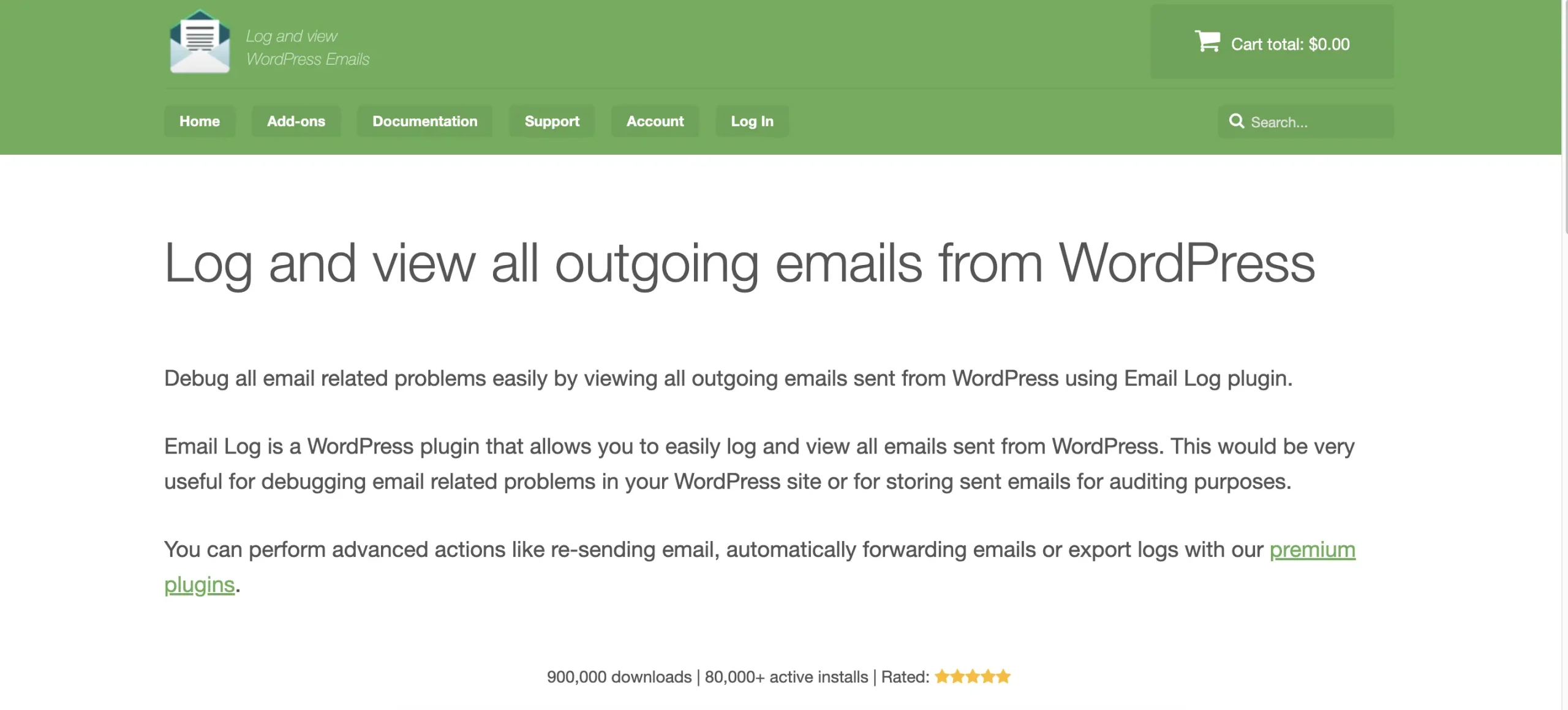
When email goes missing, so do sales, sign-ups, and trust. Order confirmations, password resets, invoices, form notifications—if they don’t arrive, users get frustrated and your team wastes hours guessing what happened. The fastest way to remove that guesswork is visibility. WP Email Log gives you a clean, searchable record of every message WordPress attempts to send, so you can diagnose issues quickly, prove what was sent, and tighten deliverability.
If you run WooCommerce, memberships/LMS, online courses, or just a busy brochure site, adding an email log is one of those small “ops” upgrades that pays off the first time something breaks.
What WP Email Log actually does
WP Email Log records each outgoing email event from WordPress with the details you need to troubleshoot: recipient, subject, timestamp, status, and headers. You can search and filter by common fields, click into any entry for the raw headers, and—when you need more—extend the workflow with add-ons like re-send, auto-forward, and export.
In plain terms: if WordPress tried to send it, you’ll see it. If there’s no log entry, the trigger didn’t fire and you can stop blaming SMTP.
Why logging matters beyond “did it send?”
Different problems present similar symptoms. A customer says “I didn’t get the email.” Is the issue that WordPress never generated it? That it was generated but blocked by your host? That it landed in spam because the message lacked proper authentication? Logs let you tell these cases apart in seconds.
Differentiate app vs mail layer. If the log shows a message with a healthy status and full headers, focus on deliverability: use a proper SMTP, set SPF/DKIM/DMARC, and check sending reputation. If there’s no entry, the application event didn’t run—maybe a plugin hook changed, a cron job failed, or a form submission never reached wp_mail().
Prove delivery attempts for audits. When someone disputes an invoice or says a reset never arrived, the log provides timestamps and technical context for your support and compliance teams.
Spot patterns you’d otherwise miss. Maybe password resets to a certain mailbox provider fail more often, or a specific contact form generates malformed headers. Patterns surface quickly when you can filter and compare events.
Typical problems it helps you solve
Customers don’t receive order confirmations or license keys.
Password resets are sporadic—some users get them, others don’t.
Contact form messages vanish or arrive hours late.
Scheduled reports “ran,” but no one received the attachment.
A plugin/theme update quietly changed headers and broke deliverability.
With a log, you can confirm the exact moment WordPress attempted to send each message and how that message looked to the mailer.

Key features you’ll use right away
Full logging of outgoing emails with searchable fields
Detailed view of headers and status (the fastest path to root cause)
Lightweight, focused UI—everything you need, no bloat
Add-ons for re-send (try again to the same or new address), auto-forward (mirror to a team inbox), and export (hand a CSV to a developer or auditor)
Adoption notes shared on the site indicate strong traction, with hundreds of thousands of downloads and a large active install base—exactly what you want from a utility plugin that becomes part of your troubleshooting toolkit.
Setup: from install to your first fix in five minutes
Install and activate. Add the plugin from your dashboard (or upload the PRO zip) and make sure the menu item appears.
Trigger a test email. Use a contact form, password reset, or a test WooCommerce order so the site emits at least one transactional message.
Open Email Log in the admin. You should see an entry for your test.
Inspect the record. Click into the row to view headers, status, and timestamps. Confirm that WordPress attempted to send, and note the From address and sender domain.
Fix the obvious issues. If emails are logged but not received, configure a dedicated SMTP with correct SPF/DKIM and use a domain-aligned From address. If there’s no log entry, check plugin hooks, form settings, and cron status.
Enable add-ons as needed. Auto-forward to a shared mailbox for oversight, or use re-send for one-off recoveries without recreating the original event.
A simple debugging playbook you can copy
Scenario A: “Order email didn’t arrive.”
Search by the customer’s email in the log. If found, compare the timestamp to their order time. If headers look OK, focus on deliverability (spam folder, mailbox provider filters, domain authentication). If not found, verify the WooCommerce email trigger and template status.
Scenario B: “Password resets work for Gmail but not for CompanyMail.”
Filter by subject “Password Reset” and group by recipient domain. If a specific provider shows higher failure, check their anti-spam rules and align your message/auth settings. Consider throttling or using a reputable SMTP with a warmed-up IP.
Scenario C: “Form emails disappeared after a plugin update.”
Submit a new form entry and refresh the log. If the entry is missing, the form is no longer calling wp_mail() correctly—check the plugin’s email settings and compatibility notes. If the entry exists, the update likely altered headers; fix From/reply-to and retest via SMTP.
WooCommerce and high-volume sites
Transactional email is revenue-critical. Stores, membership platforms, and LMS sites rely on confirmations, renewals, and receipts to keep customers informed. WP Email Log gives support instant visibility (search by address or subject), provides audit trails for refunds and license keys, and increases confidence during promos or migrations when volume spikes and deliverability is under pressure. After a major campaign or host move, watching the log for a few days is a smart safety check.
Privacy, data hygiene, and retention
Email logs can contain personally identifiable information. Treat them with the same care as other operational records.
Set a sensible retention window (often 30–90 days), long enough to debug and audit but not “forever.”
Restrict access to trusted roles only.
Avoid logging unnecessary content long-term; use the log to diagnose, not to archive user communication.
When to use add-ons
Re-send is ideal for time-sensitive messages like license keys, invoices, and password emails that a user claims they missed.
Auto-forward mirrors outgoing mail to a shared inbox, which helps agencies, compliance teams, and busy stores keep an eye on critical flows.
Export makes deeper analysis easy when a developer wants to slice failures by provider, timeframe, subject line, or sending component.
These add-ons turn a simple log into a lightweight email operations layer for WordPress, without committing to a heavier external platform.
Free vs PRO: where to start
If you just need basic visibility while you stabilize deliverability, install WP Email Log from WordPress.org to get a feel for the flow: WP Email Log
When you want re-send, auto-forward, export, and priority support for team processes, go PRO with the plugin linked at the top. Keeping the workflow inside WordPress saves time for support and marketing, and the add-ons cover the most common “we need this now” operational needs.
Best practices to keep things reliable
Use a real SMTP sender with proper SPF, DKIM, and DMARC; don’t rely on wp_mail() + PHP mail for production.
Align your From address with the authenticated domain and keep it consistent.
Standardize the structure of critical templates (order emails, password resets) to reduce false spam flags.
Document your mail settings and keep a short runbook for “email broke” that points straight to the log screen and your SMTP dashboard.
After plugin/theme updates that touch emails, send a test and confirm a fresh entry in the log before you log off.
Final take
WP Email Log solves a specific, expensive problem with a simple interface: it shows exactly what WordPress tried to send and when. That single source of truth shortens support tickets, accelerates root-cause analysis, and helps you fix deliverability the right way. For small blogs and large stores alike, it’s a low-lift safeguard that earns its keep the first time an email goes missing.





